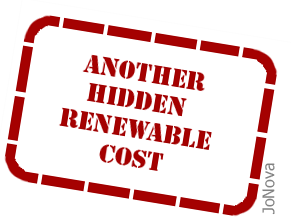The plan: The hapless homeowners will buy the back up battery for the grid and install it in their garage. Sometimes they might drive it too.
 Instead of solar and wind investors paying for the storage they need to produce useful reliable electricity, the plan, apparently, is to force the people to buy electric cars then use their batteries to save the grid instead. When someone plugs their car in to charge, the grid or their house might draw electricity out instead. It’s called two-way-charging, bi-directional charging, Vehicle-to-Grid (V2G) or Vehicle-to-Home.
Instead of solar and wind investors paying for the storage they need to produce useful reliable electricity, the plan, apparently, is to force the people to buy electric cars then use their batteries to save the grid instead. When someone plugs their car in to charge, the grid or their house might draw electricity out instead. It’s called two-way-charging, bi-directional charging, Vehicle-to-Grid (V2G) or Vehicle-to-Home.
There are moves to make this happen in California, Australia and Europe. There have already been 170 trials around the world costing millions of dollars to try to figure out how to do this. Clearly it’s a big agenda.
Repeated charges and discharges must shorten the life of the battery, and possibly inconvenience car owners too if they get caught without the fuel in the tank. What if there is family emergency at 11pm? (Well, you can catch a cab.) As well as this, every EV added to the grid is like adding “3 to 20 new houses“. Energy losses with batteries are around 20% and worse as the battery ages.
Despite the downsides, network managers are excited at the thought of using the collected mass of EV batteries to stabilize the grid, and it’s being sold as “a great way to reduce your power bills”.
Why electric car tech could drive down power prices
Jennifer Dudley-Nicholson, The Driven
A report from the Australian Renewable Energy Agency (ARENA) says the technology could become the nation’s biggest electricity storage opportunity in the next decade and has the potential to save consumers more than $6000 on the lifetime cost of charging an electric car.
“Electric vehicles offer massive, untapped storage potential,” she says.
“In 10 years, Australia’s electric car fleet is likely to have more battery capacity than Snowy 2.0 – that’s a whole lot of storage on wheels that is parked about 95 per cent of the time.”
A bill has been introduced in California to require all EV’s to have “Bi-directional” charging by 2027. GM just announced it will be standard on one of the EV series by 2026. Tesla plans to have bidirectional charging by 2025, though Elon Musk is unimpressed and says it’s ‘inconvenient‘. South Australia is already running a trial where private electric-car owners can send their battery’s energy back into their own homes.
Savings are listed “per decade” — it’s that bad:
The greatest savings could be unlocked by drivers in South Australia and NSW, the report found, while those in Queensland and the ACT could access smaller discounts of more than $1000 over a decade.
So that’s a big $100 a year discount for people in Queensland or the ACT for the more rapid devaluation of an asset that costs $60,000 to $100,000? It may shorten the life of the car by a year or two, and increase the risk of house fires, but otherwise it’s a “great idea”.
This partly explains the push for mass forced uptake of EV’s — they are the big band-aid for unreliable renewable-grids. It’s obviously not about “saving us from climate change” because no one is even sure if EV’s will reduce emissions (and the emissions are beneficial anyway). What EV’s will enable (apart from tracking, spying, sabotage and remote control) is more stability on fragile grids burdened with too many wind and solar plants. But how does this make any sense when grids need to add generation to charge the EV’s?
The Australian ARENA Report admits it isn’t cost effective even at the high prices of last year:
The REVS trial used 51 Nissan Leaf cars in Canberra to examine the cost effectiveness of using car batteries to improve grid “energy stability”. But they concluded it wasn’t worth it yet, which was a shame because the trial itself cost $2.7 million.
“Today, V2G has challenging economics. But in some niche use cases, where vehicles are plugged in for extended periods, V2G could soon be economic. In most cases charger prices still need to drop before V2G is economic.”
Of course, if the corrupt management of the grid makes electricity prices expensive enough, sooner or later it will “make sense” to use your car as a grid stabilizer to save a few dollars. They just need to screw up the market some more to make EV-dis-charging “appealing”.
As Stephen Green said imagine the government wanted to siphon your gas tank?
You go to the gas station to top off your tank for a long road trip. Unbeknownst to you, the gas station is actually a little low on gas because the manager forgot to call Shell HQ and order a tanker truck for a refill. When you stick the gas pump in the side of your car, the intelligent pump notices that you’ve actually got more than half a tank. So instead of pumping gas into your car, the gas station siphons a gallon out of it. Just to stabilize the station’s supply, don’t you know?
Depending on how much control householders have of their “smart” charger, and how aggressive governments are with “incentives” it’s a fair question to ask, “who owns the battery”? Like rooftop solar panels and air conditioners controlled by government agencies, more of what we thought we owned is really just rented from “the State”.
You will own nothing…
EV charging image by Nerijus jakimavičius
